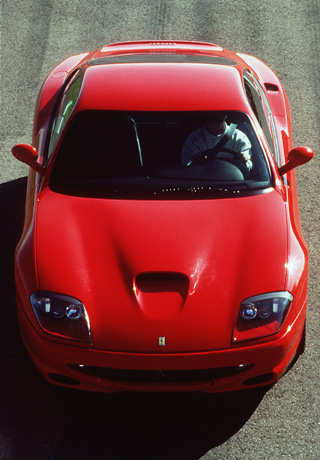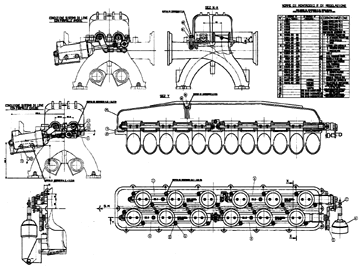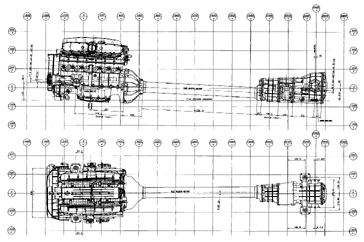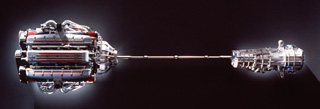|
|
|
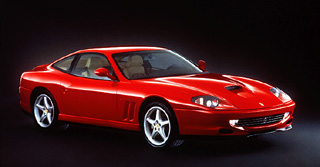
|
THE HORSEPOWER AND HOW IT IS CONTROLLED
The engine The engine that powers the 550 maranello is a 334 cu x in unit with 12 cylinders in a 65 ° V, whose most outstanding feature is the fact that it delivers peak torque from 3000 rpm, which makes it extremely elastic in all conditions. Maximum power output 485 bhp at 7000 rpm, peak torque 568.5 Nm at 5000 rpm, compression ratio: 10.8:1, bore 3.46 in, stroke 2.95 in, Bosch Motronic M5.2 ignition/injection system, weight 518 lb. The cylinder case and head and the oil sump are in light alloy with damp press-fitted aluminium cylinder liners coated in Nikasil. 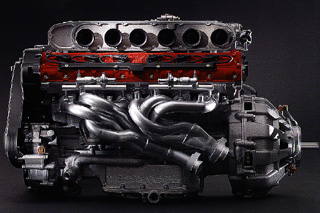
The crankshaft is supported by seven journals on anti-friction bearings of three types of metal. The con rods are in Ti6a14V titanium alloy, for constant, reliable utilisation at high speed. This has also made it possible to lighten the counter-weighting of the drive shaft, which improves the response and balance of the mechanical masses. The Mahle forges aluminium alloy pistons have a particular crown design to enhance the thermodynamic efficiency of the combustion chamber. Lubrication is by dry sump with two recovery pumps and one input pump, double filter, separate tank and special radiator. Cylinder head with hydraulic tappets 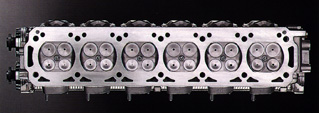
The cylinder head, with four valves per cylinder, is fitted with hydraulic tappets. This system helps to curb the level of polluting emissions, making it unnecessary to periodically adjust tappet play, and guaranteeing constant engine performance. The variable geometry intake Ferrari developed a particular type of variable geometry intake for the 550 maranello engine to enhance torque and power features. The system, patented by Ferrari, comprises a third capacity added to the intake manifold, which alters its fluodynamic characteristics. The third capacity is linked to the manifold by 12 throttle valves with electropneumatic servo control, driven by the engine management control units. The additional capacity means that the air flow has a longer length in which to "resound", improving combustion chamber filling and enhancing engine efficiency. This translates into optimised engine performance at all speeds, extremely elastic driving and an outstanding power output. Engine management is by an electronic Bosch Motronic 5.2 system with combined injection and static ignition. The two systems, one for each row of cylinders, are linked by a high speed serial line (CAN). Exhaust system with variable back pressure 
Particular attention went into the design of the exhaust system, resulting in a system with variable back pressure (similar to that on the F 50), and by-pass valves situated on the rear silencers. The by-pass valves are activated by an electropneumatic servo governed by the engine management system, on the basis of engine speed and throttle valve. The possibility of governing the back pressure at the exhaust also makes it possible to optimise engine efficiency in the various use conditions. Greater back pressure, with the valve closed, allows the torque to be improved in average load conditions, while reduction of the back pressure at the exhaust by opening the by-pass valves enhances engine efficiency at high speeds with a full load. The exhaust system is in insulated stainless steel with "six into two into one" mixing nodes for each row. The system has two input lines into the silencer. Transmission The layout of the car is classical, with a front engine and rear wheel drive. The differential unit incorporates the gearbox, and is positioned at the rear (transaxle) for better weight distribution. This solution makes it possible to distribute weight equally between the axles with the driver on board. Drive is transmitted by the clutch to the gearbox by a propeller shaft supported by three bearings and housed in a rigid steel tube which links the engine and the gearbox. The single plate dry clutch is mounted on the flywheel and is driven hydraulically. The gearbox has six synchronised speeds plus reverse. The synchronisers are of the dual cone type. Lubrication is pressurised, with an oil pump and radiator. Gearbox control is the classic Ferrari type with an aluminium knob, lever and grooved selector; commands are transmitted by a rigid shift. Gear ratios
On board |

